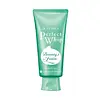What's inside
What's inside
 Key Ingredients
Key Ingredients

 Benefits
Benefits

 Concerns
Concerns

 Ingredients Side-by-side
Ingredients Side-by-side

Water
Skin ConditioningStearic Acid
CleansingMyristic Acid
CleansingPEG-8
HumectantPotassium Hydroxide
BufferingLauric Acid
CleansingGlycerin
HumectantDipropylene Glycol
HumectantBeeswax
Emulsion StabilisingPolyquaternium-7
PEG-90m
Emulsion StabilisingPEG/PPG-14/7 Dimethyl Ether
Skin ConditioningSodium Hyaluronate
HumectantSericin
Skin ConditioningSodium Acetylated Hyaluronate
HumectantChamomilla Recutita Flower Extract
MaskingAlcohol
AntimicrobialSalicylic Acid
MaskingDisodium EDTA
Sodium Metabisulfite
AntioxidantButylene Glycol
HumectantCitric Acid
BufferingPotassium Sorbate
PreservativeSilica
AbrasiveBHT
AntioxidantSodium Benzoate
MaskingParfum
MaskingCI 17200
Cosmetic ColorantCI 15985
Cosmetic ColorantCI 61570
Cosmetic ColorantWater, Stearic Acid, Myristic Acid, PEG-8, Potassium Hydroxide, Lauric Acid, Glycerin, Dipropylene Glycol, Beeswax, Polyquaternium-7, PEG-90m, PEG/PPG-14/7 Dimethyl Ether, Sodium Hyaluronate, Sericin, Sodium Acetylated Hyaluronate, Chamomilla Recutita Flower Extract, Alcohol, Salicylic Acid, Disodium EDTA, Sodium Metabisulfite, Butylene Glycol, Citric Acid, Potassium Sorbate, Silica, BHT, Sodium Benzoate, Parfum, CI 17200, CI 15985, CI 61570
Water
Skin ConditioningGlycerin
HumectantPalmitoyl Glycine
CleansingSodium Cocoyl Glycinate
CleansingStearoyl Glutamic Acid
CleansingSodium Lauroamphoacetate
CleansingCocamidopropyl Hydroxysultaine
CleansingOlive Oil PEG-7 Esters
EmollientPEG-120 Methyl Glucose Dioleate
EmulsifyingSodium Phosphate
BufferingGlyceryl Stearate
EmollientPotassium Hydroxide
Buffering1,2-Hexanediol
Skin ConditioningHydroxyacetophenone
AntioxidantLactobacillus Ferment
Skin ConditioningInulin
Skin ConditioningLactobacillus/Rice Ferment
Skin ConditioningPhyllacantha Fibrosa Extract
Skin ConditioningLactococcus Ferment
Skin ConditioningBacillus Ferment
Skin ConditioningZea Mays Kernel Extract
Alpha-Glucan Oligosaccharide
CleansingDimethylsilanol Hyaluronate
HumectantSodium Hyaluronate
HumectantCedrus Atlantica Bark Oil
MaskingCorn Starch Modified
AbsorbentRicinus Communis Seed Oil
MaskingPentylene Glycol
Skin ConditioningBetaine
HumectantXanthan Gum
EmulsifyingPolyquaternium-39
Tocopherol
AntioxidantPropylparaben
PreservativeSodium Chloride
MaskingDisodium EDTA
Ethylhexylglycerin
Skin ConditioningPhenoxyethanol
PreservativeMethylparaben
PreservativeWater, Glycerin, Palmitoyl Glycine, Sodium Cocoyl Glycinate, Stearoyl Glutamic Acid, Sodium Lauroamphoacetate, Cocamidopropyl Hydroxysultaine, Olive Oil PEG-7 Esters, PEG-120 Methyl Glucose Dioleate, Sodium Phosphate, Glyceryl Stearate, Potassium Hydroxide, 1,2-Hexanediol, Hydroxyacetophenone, Lactobacillus Ferment, Inulin, Lactobacillus/Rice Ferment, Phyllacantha Fibrosa Extract, Lactococcus Ferment, Bacillus Ferment, Zea Mays Kernel Extract, Alpha-Glucan Oligosaccharide, Dimethylsilanol Hyaluronate, Sodium Hyaluronate, Cedrus Atlantica Bark Oil, Corn Starch Modified, Ricinus Communis Seed Oil, Pentylene Glycol, Betaine, Xanthan Gum, Polyquaternium-39, Tocopherol, Propylparaben, Sodium Chloride, Disodium EDTA, Ethylhexylglycerin, Phenoxyethanol, Methylparaben
 Reviews
Reviews

Ingredients Explained
These ingredients are found in both products.
Ingredients higher up in an ingredient list are typically present in a larger amount.
Disodium EDTA plays a role in making products more stable by aiding other preservatives.
It is a chelating agent, meaning it neutralizes metal ions that may be found in a product.
Disodium EDTA is a salt of edetic acid and is found to be safe in cosmetic ingredients.
Learn more about Disodium EDTAGlycerin is already naturally found in your skin. It helps moisturize and protect your skin.
A study from 2016 found glycerin to be more effective as a humectant than AHAs and hyaluronic acid.
As a humectant, it helps the skin stay hydrated by pulling moisture to your skin. The low molecular weight of glycerin allows it to pull moisture into the deeper layers of your skin.
Hydrated skin improves your skin barrier; Your skin barrier helps protect against irritants and bacteria.
Glycerin has also been found to have antimicrobial and antiviral properties. Due to these properties, glycerin is often used in wound and burn treatments.
In cosmetics, glycerin is usually derived from plants such as soybean or palm. However, it can also be sourced from animals, such as tallow or animal fat.
This ingredient is organic, colorless, odorless, and non-toxic.
Glycerin is the name for this ingredient in American English. British English uses Glycerol/Glycerine.
Learn more about GlycerinPotassium hydroxide is commonly known as caustic potash. It is used to fix the pH of a product or as a cleaning agent in soap. In cleansers, it is used for the saponification of oils.
Sapnification is the process of creating fatty acid metal salts from triglycerides and a strong base. During this process, Potassium Hydroxide is used up and is not present in the final product.
Using high concentrations of Potassium Hydroxide have shown to irritate the skin.
Learn more about Potassium HydroxideSodium Hyaluronate is hyaluronic acid's salt form. It is commonly derived from the sodium salt of hyaluronic acid.
Like hyaluronic acid, it is great at holding water and acts as a humectant. This makes it a great skin hydrating ingredient.
Sodium Hyaluronate is naturally occurring in our bodies and is mostly found in eye fluid and joints.
These are some other common types of Hyaluronic Acid:
Learn more about Sodium HyaluronateWater. It's the most common cosmetic ingredient of all. You'll usually see it at the top of ingredient lists, meaning that it makes up the largest part of the product.
So why is it so popular? Water most often acts as a solvent - this means that it helps dissolve other ingredients into the formulation.
You'll also recognize water as that liquid we all need to stay alive. If you see this, drink a glass of water. Stay hydrated!
Learn more about Water